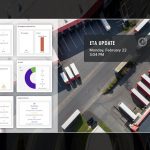Industry Talk
Regular Industry Development Updates, Opinions and Talking Points relating to Manufacturing, the Supply Chain and Logistics.The Integrated Supply Chain: Fusing Data to Anticipate Demand

The last months have piled pressure on the economy, with all industries feeling the strain. From a consumer perspective, empty shelves and extended delivery times have highlighted holes in local and global supply chains.
With the impact of coronavirus likely to be long term, with new cases expected until at least 2024, the supply chain industry must embrace technology to meet with current and future volatility.
Frequently oversimplified, the modern supply chain is infinitely more complex than simple package delivery. It involves managing supply needs to include what comes before delivery, as well as after, analysing behaviour, events, weather, output, and crucially, location, to build a proactive image of demand.
To meet the challenge ahead, we must embrace the Internet of Things (IoT) to fuse supply chain data with other datasets, shifting from a reactionary to a proactive approach using data.
Data Fusion
The use of analytics to leverage historical data to uncover real-time insights and to predict future events is widely applied across industries. Recent years have seen an unprecedented convergence of tools and techniques to make analytics and modelling more accessible than ever before. Today, there is the ability to capture the vast quantities of data generated by the Internet of Things (IoT), embed analytics and add-on automation and machine learning.
While organisations have the power to extract value from previously unexplored data, including geospatial information, rarely are these datasets combined with those from other sectors.
Harnessing the extensive existing data from every touchpoint, from mobiles to trains, can provide sophisticated environmental sensing. When combined with additional datasets such as physical points of interest, and rapid large-scale location data analytics, it can provide full situational, contextual intelligence. Such location intelligence is crucial for building effective supply chains, which underpins healthcare resource management and economic continuity.
An Integrated model
This integrated model, which fuses all possible datasets, has the potential to revolutionise supply and demand, building in resilience and efficiency. In particular it can:
Minimise Threats – Combining multiple datasets improves behaviour patterns analysis and minimises the impact of market changes. As the pandemic continues to impact regions differently, data fusion can holistically examine activity and share proactive abnormalities that may indicate vulnerabilities and advanced threats to the supply.
Optimise Operations – Global visibility is fundamental to forecasting inventory, managing resources and building contingency plans. The coming years are likely to see companies look to develop their resilience while maintaining maximum operational efficiency. Pulling data from multiple sources enables businesses and governments to understand and predict pricing, travel and markets to function more efficiently.
Improve Intelligence – Armed with improved models and an accurate understanding of activity and supply levels, companies can make better decisions. Fundamentally, they can model outcomes, create plans, and manage resources at greater ROI, while developing an achievable schedule. Such intelligence can help to ensure only effective projects are taken on, while risk is minimised.
Streamline Resourcing – One of the vulnerabilities exposed in recent months has been the management of resources. Overstocking or broken supply chains, both in terms of material and staffing, have had a severe impact on the overall economy. Integrating datasets enables location predictions on demand and more advanced models to be created. This can help to proactively avoid bottlenecks by adjusting schedules to separate peaks in demand, spur partnerships and maximise efficiency. That allows a much more thoughtful, fact-based discussion – far preferable to missed deadlines or subpar products.
The Next Generation of Supply and Demand
Effective digital supply chains are underpinned by technology that can fuse multiple different datasets and enable advanced and precise analytics. This means that sectors, both public and private, must collaborate to achieve maximum efficiency.
Data collaboration is fundamental to a more productive future. With new and varied insights, businesses can make more informed decisions to build a better, more resilient global economy. A holistic view of all activity and operations allows the prediction of demand and the production of the right products, at the right time, in the right areas. These can be delivered to customers where and when they want them.










